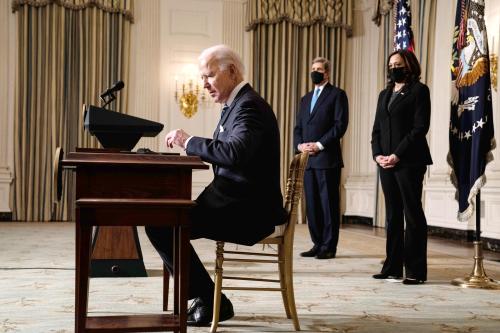Next week’s U.N. Climate Action Summit in New York, and the roughly yearlong process it will kick off, presents the world with a challenge. On the one hand, the science of climate change is clear and it points to a need for a substantially enhanced global response—and quickly. Over the next year, as part of processes from the Paris climate agreement, countries around the world will re-evaluate their commitment to reducing emissions domestically. On the other hand, there is concern that the world, and particularly key individual countries that are essential to the solution, are wavering on their earlier commitments and, in some cases, pursuing strategies that are contrary to solving the problem. The Summit itself will undoubtedly reflect this tension, representing at once a confluence of voices eager to see enhanced commitments from national leaders, and some national governments unsure of how forward they should be about the timing and pace of their commitments.
Given these tensions, the Summit cannot deliver a globally comprehensive set of new national-level climate commitments—during either the pre-summit working meetings on September 21 and 22 nor during on the actual day of the summit on September 23. However, by highlighting examples of current action and prompting some leading commitments by groups of stakeholders and some individual countries, the Summit can help world leaders to coalesce around the ambitious expectations that will be needed as countries evaluate their options for revising their existing climate strategies and look ahead to make new ones. One approach that may bear fruit is a set of collaborative workstreams that seek to facilitate action across governments and other stakeholders, for example on industry transitions, energy transitions, and analyzing and pricing climate risks and resilience for the private sector. While outcomes across the workstreams depend on continued work over the next few weeks, positive outcomes on any of them will support the ability of many countries to make additional incremental progress.
That said, the overarching Summit goal is to advance global action on climate change, with the biggest indicator of success being whether countries commit to, and implement, national targets and strategies that allow them to get on a pathway toward significant global reductions by 2030. This theme of “raising ambition” forms the core of Summit and may well be the subject of an agreement about collective intent (and perhaps even some new national commitments). Translating that intent, however sincere, into a globally significant assemblage of national commitments will be the defining global challenge of the next 15 months. This is the true test of the Summit—and the outcome will become apparent as individual countries begin to submit their formal national targets and commitments under the Paris agreement (called Nationally Determined Contributions, or NDCs).
As countries enter this ambition-raising phase with respect to their national climate strategies, the global political context offers several causes for concern. Several key emitters, notably including the United States, Australia, and Brazil, currently have national governments that are oppositional or hesitant about taking on additional commitments. Moreover, while most key emitters continue to remain part of the Paris Agreement and work actively to drive their emissions down, the loss of the U.S. bully pulpit and foreign policy apparatus in global policy has left a gap in leadership on international ambition. And because of the collective action dimension of climate, the Paris Agreement depends on a cycle of ambitious action by key emitters to provide support for internal domestic processes in all countries.
Creating new levels of ambition
Compared to just a few years ago, though, there have also been some positive—and in some cases surprising—developments that point the way toward strategies that can not only work around these existing challenges but also offer the real possibility of supporting new levels of ambition that would not have been thinkable. First, technology costs continue to decline at rates that have shifted the set of possibilities for national economies. Perhaps the most telling aggregate indicator of this was reported by the International Renewable Energy Agency, which demonstrated that new clean energy costs are competitive with and in many regions lower than comparable costs for fossil fueled energy. Second, the politics of coal retirement and cancellation are shifting rapidly, not only in the U.S. but globally. Compared to 2016, global proposed new coal power generation capacity has decreased by more than 60 percent from 1,282 GW to 502 GW, largely driven by policies in China. In addition, a group of over 80 countries, states, and other organizations have announced plans to phase out coal plants within the next 10 to 15 years as part of the Powering Past Coal Alliance.
Third, and critically, new experience since the first round of targets under the Paris shows the potential of a new and more robust, comprehensive climate strategy to generate national ambition. This strategy focuses not only on national governments but also includes efforts from subnational governments and other organizations within national jurisdictions. The spotlight has conventionally shone on national policy, with some justification, because in most countries, national governments retain prime control of some major policy actions. However, by focusing on this spotlight, essential opportunities and groundwork by non-national actors have often been overlooked. Cities, provinces, states, businesses, counties, regional networks, and others have, in many parts of the world, demonstrated significant climate ambition in many cases beyond that of their national governments. While their policy platforms are by definition narrower in geographic scope, they are at times significant—U.S. states and Canadian provinces, for example, exert significant control over their energy policies—and when aggregated across countries, can add up to a major additional contribution to support higher national ambition.
Evidence for the significant potential of this strategy comes out of the country that is perhaps the most challenged currently at the level of national leadership—the United States. While the view of American climate action can easily be conflated with the voice and actions of the president, climate politics in the U.S. are pointing in a very different direction. The midterm elections, for example, swept in new climate leadership in state legislatures. The U.S. Climate Alliance of States now counts 25 governors of both parties, representing 55 percent of the U.S. population and over 40 percent of U.S. emissions. In addition, work I conducted with colleagues as part of the America’s Pledge Initiative on Climate Change demonstrated that such actions were not only resulting in significant impacts on emissions today—driving them down to reach nearly two-thirds of the way to the U.S. Paris target, but could also deliver additional emissions reductions close to the previous U.S. national target when scaled up—results that could be significantly accelerated were the U.S. to re-engage with climate policy after the 2020 elections.
Addressing the call of the Summit
Comprehensive national strategies that then layer national policies over the leadership and actions from cities, states, businesses, and other organizations can address two central challenges for raising national ambition—and are therefore central to answering the call of the Summit. First, because they leverage leadership across the economy, they have the potential to squeeze out additional actions where the national governments may not have seen it, or where they may not have had policy levers. Second, because they build on distributed political processes from the bottom up, they are more durable and have a greater chance of being implemented than strategies generated exclusively from the top down.
This key policy innovation thus provides a route toward building groundwork today that can support national ambition in the near future, in countries across the spectrum of current support. Infusing the Summit’s ambition discussion with this principle will be a core strategy toward a successful long-term policy and climate outcome.
The Brookings Institution is committed to quality, independence, and impact.
We are supported by a diverse array of funders. In line with our values and policies, each Brookings publication represents the sole views of its author(s).










Commentary
Success from the UN climate summit will hinge on new ways to build national action
September 17, 2019